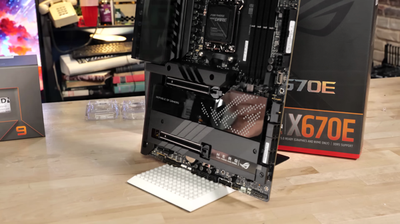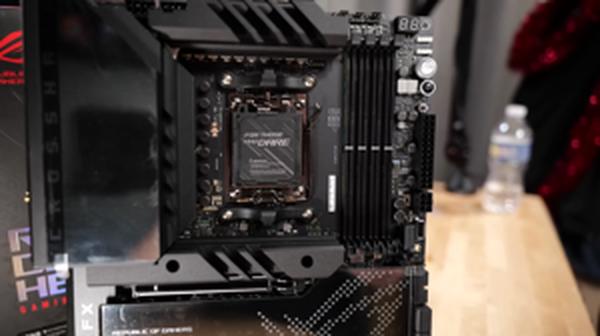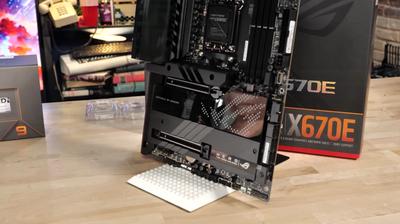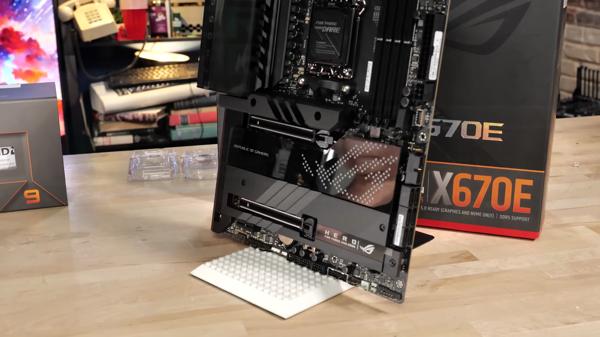
My impressions of the ASUS ROG Crosshair X670E Extreme AM5 EATX Motherboard (2024)
My thoughts on the ASUS ROG Crosshair X670E Extreme: technology, performance, connectivity, and value.
Introduction
I've been using the ASUS ROG Crosshair X670E Extreme motherboard for a few months now, coupled with my AMD Ryzen 7000 Series processor. Below are my impressions of its performance, cooling, and overall value in a high-end PC build.
Some photos (click to enlarge)




Specs of the ASUS ROG Crosshair X670E Extreme Motherboard
- Release Year
- Brand
- Chipset Type
- Compatible Devices
- Compatible Processors
- Cpu Socket
- Memory Clock Speed
- Memory Storage Capacity
- Model Name
- Platform
- Ram Memory Technology
Prices
Cutting-edge Technology and Performance Prowess

The ASUS ROG Crosshair X670E Extreme motherboard is quite the powerhouse, matching the needs of someone like me, who is always chasing the next level of performance. The motherboard leverages the AMD Ryzen 7000 Series processors with the AM5 socket, ensuring that I'm equipped with the latest tech for my gaming and heavy-duty computing tasks. But let's break it down:
Powerful VRM: The 20+2 power stage design is more than capable of handling the high demands of overclocking, and believe me, the Ryzen chips do like to guzzle power when pushed to their limits.
Effective Cooling: With a wealth of heatsinks and the intriguing ROG Water-Cooling Zone, I'm assured that thermals won't throttle my performance aspirations.
AI-Driven Utilities: Features like AI Cooling II and AI Networking take the guesswork out of tuning the system, which is a time-saver.
But it's not all rainbows. Despite the intelligent controls and impeccable build quality, this motherboard comes with a hefty price tag. Some users may find the DDR5 compatibility limitations a bit of a letdown, especially when shelling out top dollar with the expectation of unrestricted high-speed memory use.
There's no denying that the ASUS ROG Crosshair X670E Extreme is at the apex of what modern motherboards offer, especially in terms of build quality and feature set. The inclusion of Wi-Fi 6E and myriad high-speed USB ports ensures connectivity won't be a bottleneck, and the board's aesthetics, with its RGB capabilities, sync smoothly within my gaming setup to add that premium visual flair which I personally enjoy.
Yet, there's the niggling consideration of practicality. Not everyone needs this level of "extreme," and for some, the gains may not justify the investment. For those simply wanting to game or carry out everyday tasks, there are more cost-effective alternatives that won't make much of a discernible difference in performance during everyday use.
In essence, this motherboard is for the tech enthusiast who wants to squeeze out every bit of performance possible and delight in the nuance of high-end features. It's for someone who, like me, appreciates the craftsmanship that goes into creating such a platform and sees value beyond sheer specs. The ROG Crosshair X670E Extreme is a testament to what technology can achieve when performance is the priority. But be mindful of your needs and whether all the bells and whistles will truly enhance your computing experience or just look pretty in the case.
Connectivity and Expansion Opportunities

When building a high-end PC, connectivity and expansion capabilities are key considerations, and the ASUS ROG Crosshair X670E Extreme ticks nearly every box here. Let's break down what this motherboard brings to the table:
USB4 ports: With up to 40 Gbps of bidirectional bandwidth, these ports are a game-changer for data transfer and external display support.
Wi-Fi 6E and 10Gb Ethernet: For online gaming or high-speed network transfers, these features ensure minimal lag and peak networking performance.
DDR5 Compatibility: The ability to handle the latest RAM technology is a must, and this motherboard doesn't disappoint, supporting memory clock speeds up to 6400 MHz.
However, no product is without its drawbacks. Considering the cutting-edge features, the EATX form factor of this board can be a bit too large for some cases, potentially creating a tight fit or limiting your case choices. And, while the board supports DDR5 RAM, some users have found issues reaching the very top speeds offered by the latest RAM modules without the system reverting to a BIOS safe mode. This is a bit of a letdown, especially if you've invested in high-end memory.
From a personal standpoint, I'm impressed by the abundance of onboard connectivity options. Having multiple M.2 slots with heatsinks is a huge plus, and the fact that this board comes with PCIe Gen 5 support is a clear indication that it's future-proofed for upcoming high-speed SSDs. I'm also a big fan of the onboard 10Gb and 2.5Gb Ethernet as it opens the door for a versatile home network setup.
However, it's worth noting the size of the board—and by extension, the space its additional features occupy—can prove to be a bit of a puzzle when installing it in a case. You would need to ensure that your case can accommodate an EATX motherboard without hindering other components, especially around the SATA and USB headers.
One aspect that could be a potential hiccup is the BIOS experience. Some users have reported difficulty with POST and the BIOS setup, which might be daunting for first-time builders. Ensuring a smooth setup process with adequate support documents could significantly enhance the user experience.
In essence, the ASUS ROG Crosshair X670E Extreme stands as a hub of connectivity and expansion that most enthusiasts could wish for, albeit with a few considerations to keep in mind. For anyone aiming to build a system that stays relevant far into the future and maximizes the potential of their other high-end components, these trade-offs may be well worth it.
Overclocking and System Control Mastery

When it comes to pushing the limits of what my processor can achieve, I've found that certain motherboards stand out from the pack. The ASUS ROG Crosshair X670E Extreme is a beast of a board, especially for those of us who love to tweak and tune every aspect of our systems. From my experience, here's my breakdown of overclocking and the level of system control mastery you can expect:
Efficient Power Management: The 20 plus 2 teamed power stages are overkill for most, but they show their strength when you're pushing for high overclocks. You can really crank up the settings without worrying about power delivery.
Dynamic OC Switcher: This feature is a godsend. It dynamically adjusts overclocks based on system loads, expertly balancing performance with stability.
Core Flex Capabilities: This hands you the keys to fine-tune power, thermal limits, and clock speeds almost artistically. It’s flexible and clearly thought out for enthusiasts.
DDR5 Support: While reaching top speeds can be tricky, once dialed in, the DDR5 support here feels future-proof, keeping pace with any high-speed RAM I throw at it.
Now the drawbacks? Although the versatility and control are top-notch, it's not for the faint of heart or those new to overclocking. The wealth of options can be overwhelming, and it takes time to learn how to harness them effectively. Moreover, I ran into a few hiccups with RAM compatibility, which required some patience and BIOS updates to resolve.
Another thing that keeps popping up in my mind is that for those enthusiastic about PBO (Precision Boost Overdrive), this motherboard makes it easier to hit that sweet spot of performance without manual tuning, which is a neat perk for less experienced overclockers.
The ROG Crosshair X670E Extreme has a suite of ASUS-exclusive tools like AI Cooling II and Two-Way AI Noise-Cancelation. These are not just fluff; they genuinely contribute to a smoother and quieter rig, especially when you're like me, continuously pushing your CPU's boundaries. Although, to be fair, I rarely hear noise because my attention is often glued to performance metrics.
But I should mention, this isn't a cheap motherboard. It's an investment, and for some, the price-to-performance benefit may not seem justified. With features like Wi-Fi 6E, 10 Gb Ethernet, and comprehensive USB4 support, you're looking at future-proofing your setup for the next several years.
So, if you're a serious overclocker or simply want system control on a level that few other boards offer, the ROG Crosshair X670E Extreme won't disappoint. For me, it's almost like the motherboard understands just how curious and demanding I am about every volt and clock speed. That said, weigh your needs against the investment, because while it offers the pinnacle of performance, it may offer more than you actually need.
Value Proposition and Market Comparison

Understanding the value of the ASUS ROG Crosshair X670E Extreme, we must weigh its offerings against the landscape of options for gaming rigs and workstations. The motherboard market, especially for the AM5 platform, is rife with alternatives, but ASUS's flagship stands out for several reasons:
Premium Build Quality: The robust power solution and thermal design are a testament to the board's resilience. Its quality components ensure longevity, which is crucial for enthusiasts who see their motherboard as a long-term investment.
Advanced Features: Features like AI Cooling II and Two-Way AI Noise-Cancellation streamline the user experience, bringing convenience and efficiency to the forefront.
Aesthetic Appeal: For those who value the visual aspect of their setup, the ROG Crosshair X670E Extreme is a stunner with its detailed design and RGB options. The ROG ID design and customizable ANIMEmatrix display provide a unique and personal touch.
However, it's also important to reference a few drawbacks, for the sake of balance:
Cost: The price point places it in the higher echelon of motherboards, which might be overkill for users whose needs don't align with the extensive feature set.
Size Constraints: Its EATX form factor may not fit all cases, and its layout can present a challenge for cable management in tighter spaces.
DDR5 Compatibility: The board’s limitations with top-speed DDR5 RAM could be a consideration for users looking to utilize the fastest memory kits available.
In conclusion, from the perspective of someone interested in both performance and aesthetics, the ASUS ROG Crosshair X670E Extreme feels like a sensible choice, albeit with some caveats. If you're after a board that oozes quality and feature-rich design, this model is undeniably enticing. It supports rigorous overclocking and future-proofing with its PCIe 5.0 provisions. It's a motherboard that seems ready to serve as the backbone of a powerhouse PC that's as much a statement piece as it is a functional tool.
Yet, practicality is key. Knowing your needs will best determine whether the investment aligns with your long-term goals. For gamers and professionals pushing for peak performance, the Crosshair X670E Extreme appears to be worth every penny. However, if you're on a tighter budget or space-constrained build, a more modest option may be the smarter, practical choice. Ultimately, it pays to remember that the most expensive does not necessarily equate to the most suitable for every user.
Comments (0)
Share